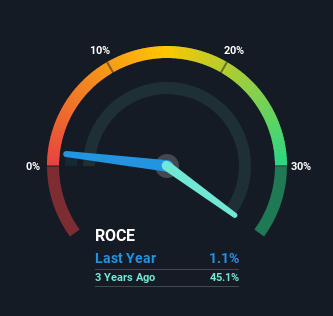Dun & Bradstreet Holdings (NYSE:DNB) Is Reinvesting At Lower Rates Of Return
Did you know there are some financial metrics that can provide clues of a potential multi-bagger? One common approach is to try and find a company with returns on capital employed (ROCE) that are increasing, in conjunction with a growing amount of capital employed. Ultimately, this demonstrates that it's a business that is reinvesting profits at increasing rates of return. However, after briefly looking over the numbers, we don't think Dun & Bradstreet Holdings (NYSE:DNB) has the makings of a multi-bagger going forward, but let's have a look at why that may be.
Return On Capital Employed (ROCE): What is it?
For those that aren't sure what ROCE is, it measures the amount of pre-tax profits a company can generate from the capital employed in its business. Analysts use this formula to calculate it for Dun & Bradstreet Holdings:
Return on Capital Employed = Earnings Before Interest and Tax (EBIT) ÷ (Total Assets - Current Liabilities)
0.011 = US$101m ÷ (US$9.9b - US$973m) (Based on the trailing twelve months to June 2021).
Therefore, Dun & Bradstreet Holdings has an ROCE of 1.1%. In absolute terms, that's a low return and it also under-performs the Professional Services industry average of 11%.
Check out our latest analysis for Dun & Bradstreet Holdings
In the above chart we have measured Dun & Bradstreet Holdings' prior ROCE against its prior performance, but the future is arguably more important. If you'd like to see what analysts are forecasting going forward, you should check out our free report for Dun & Bradstreet Holdings.
The Trend Of ROCE
In terms of Dun & Bradstreet Holdings' historical ROCE movements, the trend isn't fantastic. To be more specific, ROCE has fallen from 31% over the last five years. However, given capital employed and revenue have both increased it appears that the business is currently pursuing growth, at the consequence of short term returns. And if the increased capital generates additional returns, the business, and thus shareholders, will benefit in the long run.
On a side note, Dun & Bradstreet Holdings has done well to pay down its current liabilities to 9.9% of total assets. That could partly explain why the ROCE has dropped. Effectively this means their suppliers or short-term creditors are funding less of the business, which reduces some elements of risk. Since the business is basically funding more of its operations with it's own money, you could argue this has made the business less efficient at generating ROCE.
The Bottom Line On Dun & Bradstreet Holdings' ROCE
Even though returns on capital have fallen in the short term, we find it promising that revenue and capital employed have both increased for Dun & Bradstreet Holdings. And there could be an opportunity here if other metrics look good too, because the stock has declined 30% in the last year. As a result, we'd recommend researching this stock further to uncover what other fundamentals of the business can show us.
Dun & Bradstreet Holdings does have some risks, we noticed 2 warning signs (and 1 which is potentially serious) we think you should know about.
While Dun & Bradstreet Holdings isn't earning the highest return, check out this free list of companies that are earning high returns on equity with solid balance sheets.
This article by Simply Wall St is general in nature. We provide commentary based on historical data and analyst forecasts only using an unbiased methodology and our articles are not intended to be financial advice. It does not constitute a recommendation to buy or sell any stock, and does not take account of your objectives, or your financial situation. We aim to bring you long-term focused analysis driven by fundamental data. Note that our analysis may not factor in the latest price-sensitive company announcements or qualitative material. Simply Wall St has no position in any stocks mentioned.
Have feedback on this article? Concerned about the content? Get in touch with us directly. Alternatively, email editorial-team (at) simplywallst.com.

 Yahoo Finance
Yahoo Finance 